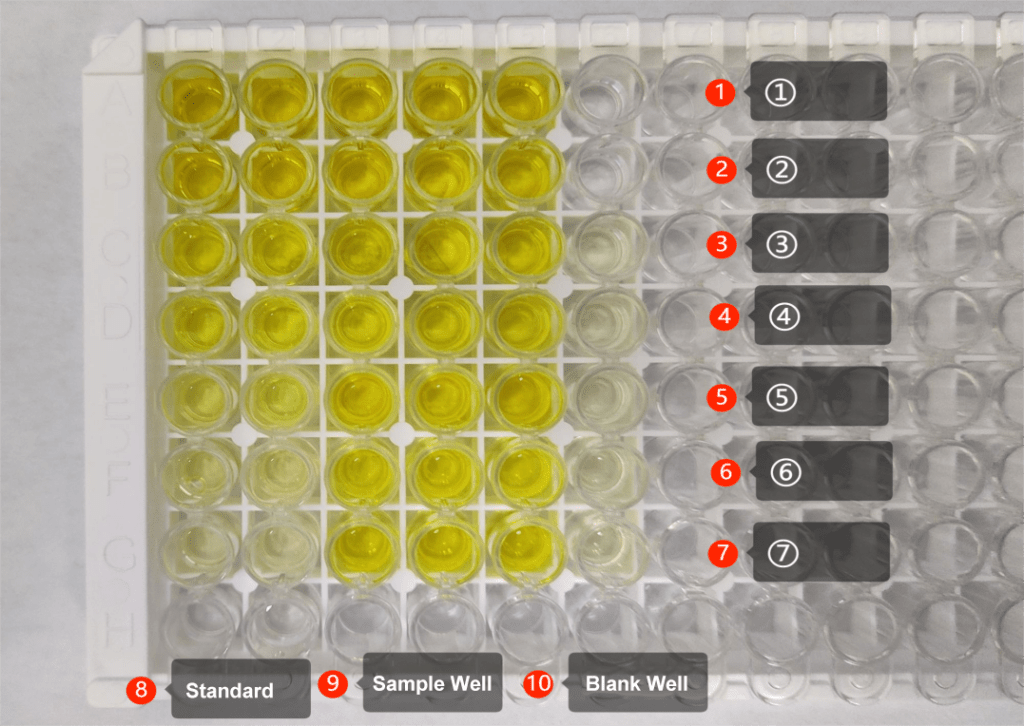Lysis buffer is a buffer used to lyse cells under non-denaturing conditions, consisting of various components such as surfactants and protease inhibitors. It is primarily used for protein extraction from cells or tissues. The ELISA assay requires that the protein in the sample is naturally structured, and that the antigen antibody reaction is incubated directly in the lysate environment. Upon tested, lysates containing Triton-X100, or NP-40 would interfere with the ELISA detection.
FineTest has optimized traditional lysis buffer formulations to gently lyse components such as animal cell membranes, cytoplasm, and nuclei, aiming to achieve maximum release of target proteins with minimal damage to them. This makes it more suitable for ELISA assay.
1. FineTest lysate Vs Conventional ripa lysate
Experiment: Comparative Analysis of FineTest's Standard Lysis Buffer (Type 1) and Conventional RIPA Lysis Buffer
With cytoplasic protein human. Casp3 assay for example, using Hela cells as test samples, lysates containing different concentrations and surfactant components were prepared for the lysis of cells, comparing ELISA test results in each group, and the experiment was repeated three times. Specifically:
Different composition of lysate:
|
①SDS 0.1% |
50mM Tris(pH 7.4), 150mM NaCl, add 1mM PMSF before use |
|
②SDS 0.5% |
50mM Tris(pH 7.4), 150mM NaCl, add 1mM PMSF before use |
|
③NP-40 1% |
50mM Tris(pH 7.4), 150mM NaCl, add 1mM PMSF before use |
|
④NP-40 5% |
50mM Tris(pH 7.4), 150mM NaCl, add 1mM PMSF before use |
|
⑤TX-100 0.1% |
50mM Tris(pH 7.4), 150mM NaCl, add 1mM PMSF before use |
|
⑥TX-100 1% |
50mM Tris(pH 7.4), 150mM NaCl, add 1mM PMSF before use |
|
⑦10mM PBS ultrasonic control |
50mM Tris(pH 7.4), 150mM NaCl, add 1mM PMSF before use |
Detection results are shown as follows:
|
Surfactant effect in the lysate (SDS/NP-40/TX-100) |
||
|
Base buffer: 50mM Tris , 0.9% NaCl,1mM PMSF PH7.2 |
||
|
human.casp3 (hela lysate) BCA: 1mg/ml |
||
|
group |
No dilution (OD450) |
|
|
2.411 |
0.088 |
|
|
2.146 |
0.093 |
|
|
③NP-40 1% |
1.822 |
0.149 |
|
④NP-40 5% |
1.758 |
0.146 |
|
⑤TX-100 0.1% |
2.053 |
0.154 |
|
⑥TX-100 1% |
1.662 |
0.148 |
|
⑦10mM PBS ultrasonic control |
2.046 |
0.195 |

From the results above, it is evident that the experiment labeled as "Type 1" (FineTest product label) yielded the best results, with the strongest target signal and the lowest background. Compared with several other lysates, our conventional 0.1% SDS was the best effect, and the experiment using "Type 6" with 1% TX-100 showed the poorest results."Type 2" with 0.5% SDS exhibited slightly diminished signal and slightly increased background due to the higher concentration of the lysis buffer, leading to partial protein denaturation.
2. Fine Biolysate Advantages
Fine biolysate's lysis buffer is specifically designed for ELISA assay, where the treated samples are directly added to wells for immune binding. Therefore, the lysis buffer needs to efficiently disrupt membranes to release internal proteins while minimizing interference with antigen-antibody reactions. Testing has shown that 1% NP-40 and 0.1% Triton X-100 significantly weaken antigen-antibody binding, whereas 0.1% SDS can effectively balance both functions without interfering with detection components.
3. Product Recommendation
|
Item Number |
Product Name |
|
FineTest Lysis Buffer (for ELISA) |
|
|
FineTest Lysis Buffer(strong) |
